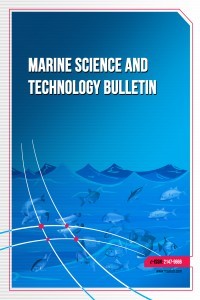
Marine Science and Technology Bulletin
Yazarlar: Deniz AYAS, Elif Ayşe ERDOĞAN ELİUZ, Ferit PERİ, Mısra BAKAN
Konular:Deniz ve Tatlı Su Biyolojisi
DOI:10.33714/masteb.480957
Anahtar Kelimeler:Dasyatis pastinaca,Raja radula,Raja clavata,Torpedo marmorata,Heavy metal,Fatty acid
Özet: In this study, it was determined the chemical composition of the four ray species (Dasyatis pastinaca, Raja radula, Raja clavata and Torpedo marmorata) caught from Mersin Bay in the Northeastern Mediterranean Sea. For this purpose, lipid levels, fatty acid profiles, macro-trace elements, and heavy metal levels in the liver and muscle tissues of the Mediterranean rays were investigated. Lipid levels of liver tissue of D. pastinaca, R. radula, R. clavata, T. marmorata were determined to be 80.21%, 53.73%, 45.57% and 45.26%, respectively; while lipid levels for muscle tissue were 1.62%, 1.31%, 1.20% and 1.43%, respectively. In the fatty acid composition of muscle tissues of the rays; ∑SFAs (total saturated fatty acids) levels were reported to be between 30.46% and 35.00%, ∑MUFAs (total saturated fatty acids) levels were 21.49% to 27.77%, ∑PUFAs (total polyunsaturated fatty acids) levels were 28.76% to 35.69%; while for liver tissues; ∑SFAs levels were reported to be between 25.76% and 31.15%, ∑MUFAs levels were 23.43% to 30.66%, ∑PUFAs levels were 21.86% to 30.54%. According to data of this current study, no potential toxic metals (Cr, As, Cd, Pb, Hg) were detected in the fish oils obtained from the tissues. Finally, it was showed that these fish had potential for fish oil production because of their having fat in the liver tissues and there were also no potential heavy metal in the both muscle oil and liver oil, being rather healthy.